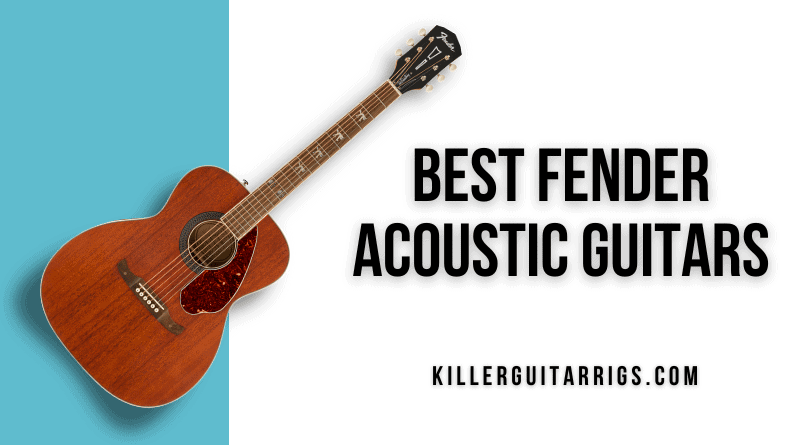From his humble origins as a Radio repair man, Leo Fender rose to become one of the most recognizable names in the music industry. After moving into amp repair, he started building his own, and from there began building the world’s first mass produced solid body electric guitar. All extremely impressive feats for a man who couldn’t even play the guitar!
In the 1960s, Fender branched out into acoustic guitars, and released their first 3 models, the King, the Concert, and the Folk. All 3 became extremely popular, and ultimately resulted in Fender releasing more and more models.
Fast forward to today, and Fender’s acoustic range is still going strong, and in fact, features some of the most innovative guitars on the market, as well as the classics. In this KillerGuitarRigs review, we’ll be taking a look at the 5 best Fender Acoustic Guitars.
We’ll be focusing on build quality, playability, tones, and features in each review. If you’ve been on the lookout for a new Fender acoustic guitar, you won’t want to miss this!
Read more about our review process.
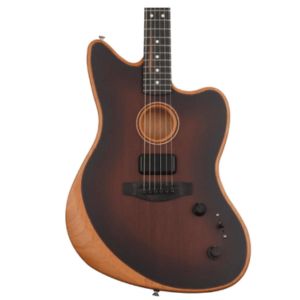
Fender American Acoustasonic Jazzmaster
Features: Fishman Matrix piezo, Shawbucker bridge pickup, SIRS mahogany body
Benefits: Real acoustic guitar resonance, 10 blendable voicings, Long battery life
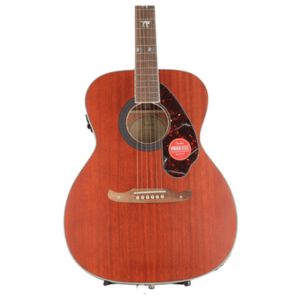
Fender Tim Armstrong Hellcat
Features: Solid mahogany top, Fishmn Tim Armstrong preamp, Unique Hellcat inlay
Benefits: Fantastic warmth, Organic amplified performance, Excellent playability
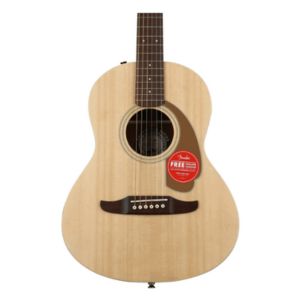
Fender Sonoran Mini
Features: Reduced size body, Spruce top, C shape neck
Benefits: Exceptional comfort, Bright tones, Responsive feel
Contents
Our Top 3
Our top pick was the Fender Tim Armstrong Hellcat. This is an amazing guitar that really offers a ton of versatility. Strum it hard, play it soft, either way, it sounds fantastic. It’s packed with great features, and it looks brilliant.
If you’re in the market for something more affordable, you’ll love our best budget option, the Fender Sonoran Mini. It’s a compact guitar with great playability, and build quality that far surpasses its price point.
On the other hand, if you’re looking for the best Fender acoustic guitar, period, then our Editor’s choice, the Fender American Acoustasonic Jazzmaster is the only way to go. It’s one of the most comfortable acoustics on the market, it sounds amazing, and the technology used on this model really is mind blowing!
Individual Reviews
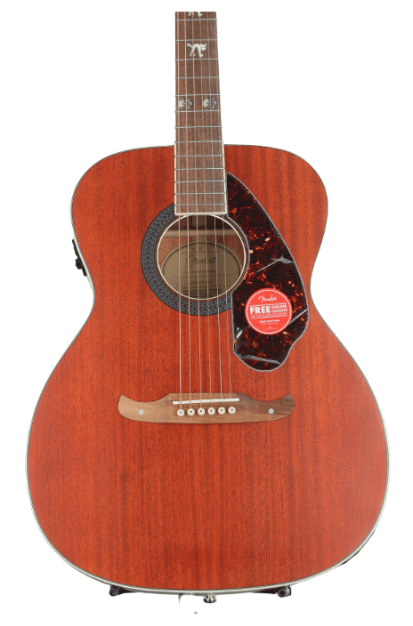
Fender Tim Armstrong Hellcat
A vintage inspired modern signature model with great tone and playability.
This is a fantastic all rounder of an acoustic guitar. It’s heavily influenced by one of the Rancid guitarist’s favorite ‘60s acoustics, and offers exceptional fit and finish considering the price.
The Fender Tim Armstrong Hellcat is the signature acoustic of the Rancid guitarist and offers a gorgeous solid mahogany top paired with aesthetically matched laminate back and sides. It’s definitely one of the more unique looking guitars in the Fender lineup, but we really happen to love it!
The body is concert style, and is constructed with advanced scalloped bracing, which helps to give it a surprisingly big voice, despite being a medium sized guitar.
Interestingly for a mahogany bodied guitar, it had a maple neck, which felt great with its C shape – a Fender neck profile we’ve come to love on practically every guitar they use it on. Topping the neck was a walnut fretboard, with 19 very nicely finished frets. There were no sharps, and the crowns were well rounded and nicely polished.
There were some nice aesthetic touches on the guitar, too, like “Hellcat” inlay on the fretboard, and a pair of skulls on the 12th fret. They gave it more of an aggressive edge than we see on most acoustics and definitely helped it stand out.
Tonally speaking it was very nicely balanced across the mids, with plenty of top end sparkle, and just enough oomph from the bottom end. Overall, it sounded great – with fingerstyle playing it was very responsive, and when strummed it was punchy enough to cut through just about any mix.
It was fitted with a Fishman Isys III pickup and preamp system, which performed exceptionally, and even featured a built in tuner. The hardware was all great quality, including the vintage style tuners, which held firm, and delivered excellent stability.
Verdict: We really enjoyed the Fender Tim Armstrong Hellcat. It’s a bit of a deviation from what we’re used to from Fender, but still offered great tone and reliable performance. It looks excellent, and with the Fishman electronics, it’s a great choice for anybody looking to get started in playing to bigger audiences.
- Solid mahogany top
- Edgy aesthetics
- Quality electronics
- Laminated back and sides
- Open gear tuners will require regular maintenance
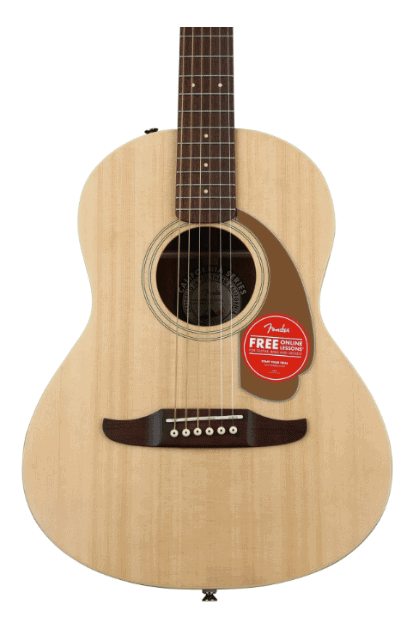
Fender Sonoran Mini
A compact strummer that’s ideal for travel.
This fantastic reduced size model makes for an excellent travel instrument, or a great first guitar for younger players. It’s extremely well built, and offers a surprisingly high spec.
The Fender Sonoran Mini is from Fender’s California Series, and really nails the west coast vibe. It’s made with a spruce top, and mahogany back and sides – a truly classic combination. The caramel colored pickguard really gave it a vintage feel, and helped it stand out in a field of tortoiseshell and black!
It had a ¾ size body in a round shouldered dreadnought shape. Like most of Fender’s budget end models, it came with scalloped X bracing, which keeps the weight down while providing great resonance and projection.
The neck was made with nyatoh (sometimes called nato), which is a mahogany substitute. It had the standard C profile, which still felt great in the hands, despite being on a smaller bodied guitar. The fretboard was made with walnut, which is a great fretboard wood that is seeing much more common use these days. We also thought very highly of the fretwork, which was extremely well finished, not even just for a budget guitar.
In addition to the touches like the caramel pickguard, it also featured a nyatoh headstock, which looked absolutely sensational, and wound up being one of our favorite things about the whole guitar.
As far as the tones went, it was biased a little towards the upper mids, but still had great balance. The trebles were really clear, and the bass and lower mids were really tight – this was probably helped along by the compact soundboard.
Even though the body was quite significantly smaller than everything else on test, it still had a 24.1” scale, which is still considered full length. We thought this really added to the playability, and helps it make a strong case as a travel guitar for adult players.
The hardware selection was well thought out. It had vintage Kluson style tuners, with nice vintage buttons. Not only did the tuners look good, but they performed well, too. Considering it’s one of the cheapest models in the Fender lineup, it came with a NuBone nut and saddle, which really helped improve the tuning stability.
Verdict: The Fender Sonoran Mini is a great choice whether you’re looking for a quality guitar for a younger player, or a solid travel or couch guitar. It sounds great, with superb balance and fantastic shimmer. Playability is great, even for larger adults, and the aesthetics are some of our favorites on any Fender.
- Extremely comfortable
- Great looks
- Excellent tuning stability
- No solid woods
- No electronics
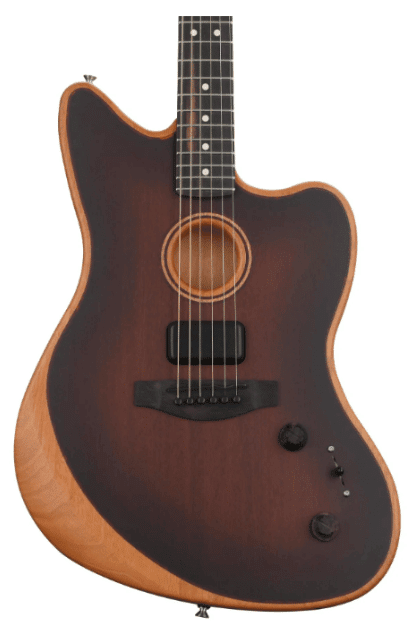
Fender American Acoustasonic Jazzmaster
Cutting edge technology with timeless tones.
This is Fender’s flagship acoustic and represents the best of the brand’s legendary quality, and their commitment to innovation. It’s a true hybrid, but really nails the acoustic look, feel and tone.
The Fender American Acoustasonic Jazzmaster is a high end acoustic hybrid that will definitely appeal to working musicians looking for an acoustic that bridges the gap between an electric guitar and a more traditional acoustic.
It was made with all mahogany on the body, and had a real solid feel to it. It wasn’t braced like a typical acoustic, but was built more like a hollow body electric. We’re big fans of Jazzmasters at KGR, so the offset JM body shape was very well received.
The neck had a modern deep C profile which felt absolutely sublime in the hand. It was made from mahogany, just like the body, and was topped with a stunning ebony fretboard. The fretwork was flawless, with perfect edges, and crowns polished to a mirror finish.
We focused more on the acoustic tones for the purpose of this review. When played unplugged, it made use of a SIRS soundport to assist with projection, and it was incredibly effective. It’s not going to keep up with a Martin Dreadnought, but it’s definitely enough to play along with a group singalong. When plugged in, it uses a specially designed acoustic engine to mimic the tones of everything from a rosewood auditorium sized model, through to a full bodied dreadnought.
Ultimately, we thought it sounded fantastic. Purists may not like the idea of a guitar like this, but even when played through an amp, it sounded like a natural unplugged acoustic.
Playability was as good as we’d expected from a US made Fender. The neck was fast, and as mentioned, felt great, and was boosted by the carved heel, which provided the best upper fret access you’re likely to find on any acoustic guitar.
Hardware was all high end, with quality Fender tuners providing impeccable tuning stability, and a GraphTech Tusq nut.
Verdict: The Fender American Acoustasonic Jazzmaster isn’t what most people would picture when you mention a high end American made acoustic guitar, but it really is a guitar that everyone should try. The tones are exceptional, and it’s effectively like having 10 guitars in one with the different voicings. Its fit and finish were superb, and aesthetically speaking it looked fantastic.
- Handsome looks
- Great tonal variety
- Exceptional build quality
- Expensive
- Not likely to appeal to traditionalists
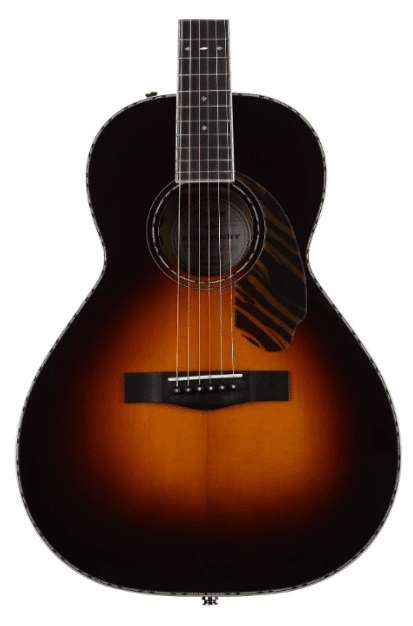
Fender PS-220E
Iconic looks and exceptional playability.
With this fantastic parlor guitar you’re getting high end construction with superb tones and great playability at a really attainable price point.
The Fender PS-220E is a beautiful parlor guitar designed for the discerning player looking for a comfortable companion that can go anywhere. It was finished in a gorgeous 3 tone vintage sunburst and was topped with a fantastic looking striped pickguard.
As mentioned, it had a parlor style body, and was built with offset x bracing, which resulted in a really full bodied sound. The top was made with Sitka spruce, and the back and sides from mahogany. This is a tried and tested combination of woods, and really suited the parlor body style well.
We really liked the C shape mahogany neck. It was slim and forgiving, and played fast, but still had enough girth to promote proper playing form. It had an ovangkol fretboard, which we actually found to be a little dry. This guitar isn’t cheap, so to see anything less than rosewood or ebony at this price point was both surprising and disappointing. Even though the fretboard was disappointing, the frets themselves were very nicely finished.
Like most parlor guitars, it had a really mellow voice that lent itself well to fingerstyle playing in particular. It wasn’t the loudest, but it was still punchy, particularly through the mids when strummed hard. This is a common trait in parlor guitars due to the elongated sound board. The spruce and mahogany combo resulted in great balance, and a really sweet overtone.
If you find that it’s not quite loud enough for you, you can always plug it in using the on board Fishman Sonitone pickup system. We found that it gave a great organic tone, but we wish there had been a side mounted preamp and EQ.
Playability was great – we didn’t find the compact body to be any kind of hindrance, and the full scale gave it a classic Fender feel. It really does make for a great travel instrument, and actually came with a fitted hard side case – not too common at this price point, and a very nice touch.
The hardware was all good quality, too. We particularly liked the art deco style tuning keys. The tuning machines worked well, and delivered easy fine tuning, and solid tuning stability.
Verdict: The PS-220E is a great choice if you’re looking for a compact Fender with great tones, and easy playability. It’s the perfect size for travel, but of course, make a great couch guitar, too. Aesthetically, it’s very pretty, and the fact that it came with a hard shell case was a fantastic surprise.
- Excellent ergonomics
- Came with hard side case
- Gorgeous body binding
- Soundhole mounted electronics
- Ovangkol fretboard
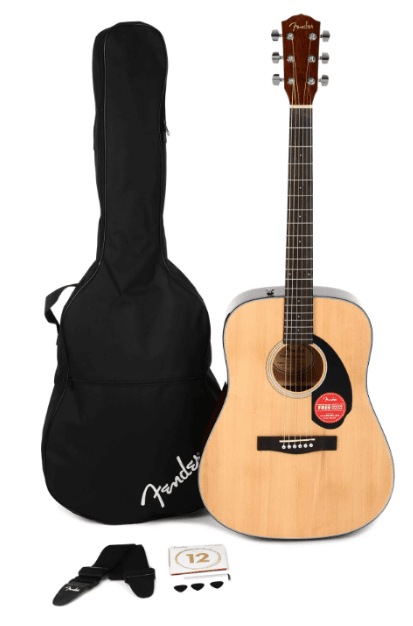
Fender CD-60S
Superb value for money in this brilliant beginner set.
This guitar represents incredible value for money thanks to its excellent construction and use of quality components. It comes with all the essentials you’ll need to get started, and makes a great platform for beginners.
The Fender CD-60S is amongst the best beginner acoustic guitars available today. It’s loaded with great features, and comes in at an incredibly attractive price point.
This is a pretty classic looking dreadnought, and amazingly for such an inexpensive guitar, it came with a solid spruce top. The back and sides were made with durable laminated mahogany, which, while not exactly exotic, certainly gets the job done. It had a natural finish, and a surprisingly pretty wood grain.
It had a nato (nyatoh) neck, just like the Sonoran Mini, and just like our best budget pick, had a C shape profile. It was comfortable, and slim – perfect for novice players. We found that the frets had nice smooth edges, but there was a little grittiness on the crowns. This is a relatively easy fix, and a small gripe when you consider the bigger picture. One big surprise was that it actually had rolled fretboard edges. This something we normally only see on high end guitars, so it was definitely a big plus here. The fretboard was made with walnut, and was actually nicer than the ovangkol we found on the PS-220E..
Tones from this guitar were really nicely balanced, with good bass response and no real muddiness. The mid range was strong, and the top end had a nice shimmer to it. A lot of budget acoustics can sound a little thin, but having a solid top gave it great resonance and sustain, which helped provide a nice depth to the tone.
Again, for the money, we found ourselves impressed with the hardware. The tuners held firm and delivered rock solid tuning stability, although the ratio did make fine tuning a little difficult. It did come with a nice gig bag, plus a tuner, strap, spare strings, and a pack of picks.
Verdict: The Fender CD-60S is a great choice for new and novice players looking for a quality guitar from a well known brand. It’s handsome, well built, and very durable – everything a new player really needs. The included accessories were great, and the tones were surprisingly robust – overall, a great choice.
- Excellent price
- All the essential accessories included
- Solid spruce top
- Laminate back and sides
- Gritty fret crowns
How To Choose The Right Fender For You
Like any other brand, when shopping for a Fender acoustic, there are a few areas you need to think about when trying to figure out which direction to go. We’ve highlighted the most important considerations below.
Body Shape
One of the most important things to consider is body shape. This impacts everything from tone to comfort and playability. Here are some of the most common body shapes that Fender offers.
Dreadnought
Dreadnought guitar bodies are probably the most popular style on the market. They’re great all purpose guitars, and work well for pretty much any style of music. This style was invented by Martin in the early 20th century, and these guitars are easily recognizable by their square shoulders, broad waist, and boxy lower bouts.
They can do lead lines and rhythm, and have huge voices with tons of volume and great projection. Tonally they’re very bass heavy, but also provide great mid range punch
Concert
Concert style guitars are considered to be medium sized, and as such are noticeably more comfortable to hold. They look more akin to a classical guitar, with curvy upper and lower bouts. Concert guitars are typically favored by fingerstyle players due to their mellower and sweeter response.
They’re well balanced in the mids, and have plenty of shimmer at the top end, but don’t quite manage the same volume as a dreadnought.
Parlor
Parlor guitars are amongst the smallest acoustic models. Despite being smaller, they typically have a full scale length, and a surprisingly big voice thanks to their elongated soundboards. These instruments make great couch strummers and travel guitars, and also happen to be really comfortable for smaller players, too.
Tone Wood
The wood that an acoustic guitar is made from makes a big difference to its tone, resonance, and sustain.
Spruce
Spruce is extremely common as an acoustic guitar tonewood, particularly on the top. It offers a bright, peppy tone with great resonance and sustain. It’s strong through the mid range and is great for both flatpicking and strumming.
Mahogany
Mahogany is most commonly used on the back and sides, and pairs very well with spruce, providing a nice balance to the brightness. Aesthetically, it’s a darker wood, and even tonally, it offers more warmth than you’d find with something like maple. When used as a sound board it makes the tone deeper, and very rich, and works very well for blues and folk.
Rosewood
Rosewood is a more expensive choice, but well worth it when you consider the incredible tonal depth and gorgeous looks that it offers. It’s usually found on high end models when used on the back and sides, but is relatively common on fretboards.
Ebony
Ebony is a very heavy wood, with an almost black appearance. It is almost exclusively used for fretboards, and offers incredible feel thanks to its extreme hardness. It looks amazing, and adds a real touch of luxury to any guitar.
Maple
Fender mostly uses maple for their necks, and it’s easy to see why. It’s extremely durable, and lends a fantastic snappiness to the tone.
Solid Wood vs. Laminate
Fender uses both solid woods and laminates in the construction of their acoustic guitars.
Solid woods are cut as single pieces from a larger selection of wood, whereas laminates use multiple layers of thinner pieces of wood compressed and glued together.
Solid woods are more difficult to work with, and are usually selected from better cuts, and as a result, tend to be more expensive. It isn’t uncommon to find a solid top on a budget guitar, but you’re very unlikely to find solid back and sides on a new acoustic under $700.
Solid woods generally improve with age, and the guitar will sound better and better as it gets older. They offer improved tone, and increased resonance and sustain compared to laminates.
Laminates aren’t without their benefits, however. Laminates tend to be harder wearing and more durable. They’re less susceptible to changes in temperature and humidity, which makes guitars made this way better for travel.
Final Thoughts
Fender’s range of acoustic guitars offers something for pretty much every player. They’ve got high tech models, classic models, and everything in between. It’s a well known brand, and their guitars really do live up to the reputation.
To recap, we really enjoyed playing all of these guitars, but our top three were really outstanding. Our top pick, the Fender Tim Armstrong Hellcat offered a great blend of price and performance. Its tones were great, and it was extremely comfortable with great playability. Our best budget choice, the Fender Sonoran Mini delivered big despite its tiny price, with a fast playing neck, and wonderful balance. Our Editor’s choice, the Fender American Acoustasonic Jazzmaster was an absolute marvel, with amazing tone, and world class build quality.

